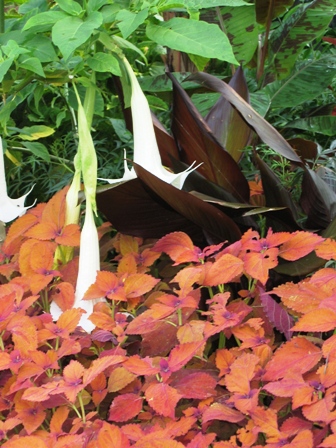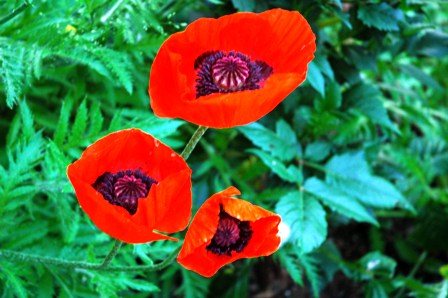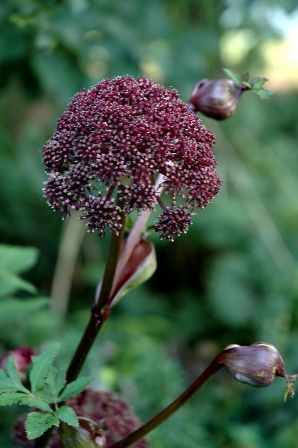In the last post on red, I talked about using red as the la piece de le resistance, as that startling, snazzy ‘something’ that will knock your socks off.
In this piece, I want to talk about red as the conductor or framework of a composition. I think gardeners find red to be such a threatening color because immediately it gets associated with the color of a red light, blood, etc….all those things we learned as a child that elicit excitement or alarm, such as the photo of these orangish-red poppies.
In fact, red, from the deepest burgundy to a soft muted almost rose color, can be soothing and the base from which so many other colors can play off of. To this day, visitors find it amazing when I show them how I use red as one of my base colors in the garden. In the first picture below, the burgundy sweet potato vine blends in beautifully with the bi-colored sharper red coleus, the delicate spidery fennel leaves and the green of the osteospermum leaves. Do you see how calming and solidifying it is?
In this second picture, all that has been added is the pale yellow osteospermum flower with its black/burgundy center. To my eye, this extra touch of burgundy, which connects directly to the sweet potato vine, makes the already good composition an even stronger one.
Another example of red acting as a subtle tour de force is seen in the photo below with the dark burgundy leaves of the coleus playing off of the deep burgundy/almost black bi-colored tones of the elephant’s ears.
Throughout my garden, I have used the Smoke bush, Cotinus coggyria, as a base color as seen in this photo with the subtle red hues on the leaves and pods of Ricinus communis, the Castor bean.
The deep wine color of Angelica gigas, as witnessed in the close up of it below, once again becomes a springboard from which all other colors can play off of. Surround it with perky yellows, soft apricots and brash oranges and you’ve got yourself one lively country garden. But if you cushion it with deep purples, soft blues, pinks and mauves then you’ve created a more romantic, potentially mysterious composition.
And then take something as simple and elegant as the soft, faded tones of these faded red with purple centered coleus planted up against the stems of what appear to be a deep burgundy canna with a sumptuous white (can you smell the scent) datura…what more could you ask for?

In the following photo, once again red acts as the base color from which all other colors respond. To my eye, the red coleus sets the pace, along with the purple/magenta/silver leaved strobilanthes. The speckled yellow leaves of the abutilon come to the forefront because it plays off of the strength of the red.
The photo below encompasses several shades of red: first in the red edged leaves of the banana leaves, the gregariousness of the bluish- red etchings in the coleus leaves, hints of the purplish/magenta from the strobilanthes beyond as well as the Cotinus coggyria at the top of the page.
So, for those of you who have found red too risky a color to use in the garden, I hope the above post has helped to alleviate some of your concerns. There are literally dozens of other plants where red is used in a subdued manner which I didn’t even attempt to show. For any of you who have photos that you’d like to share with us on this subject, either send in the link to your blog, or upload the photo to me and I’ll make sure it gets placed on the post. Any other thoughts on red?? Please share….I am always interested in learning more about this multi-faceted color.



